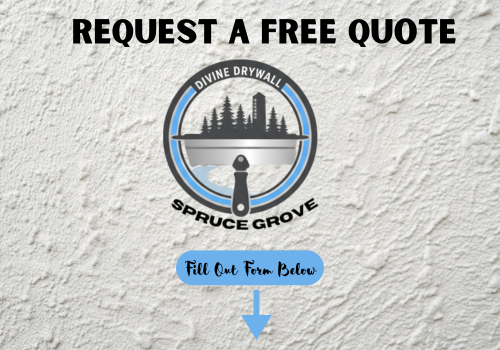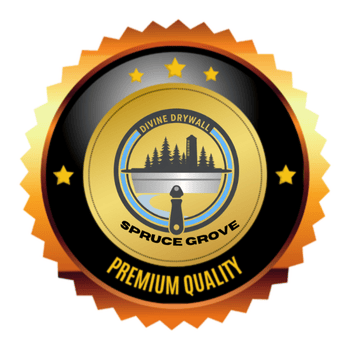Post Trade Cutout Repair in Spruce Grove, AB
Divine Drywall Spruce Grove provides specialized post trade cutout repair for homeowners dealing with the aftermath of electrical, plumbing, or HVAC work in Spruce Grove. Whether a contractor left behind a small access opening or a larger ceiling cutout, our team restores your surfaces so they blend cleanly with the rest of your home.
Repairing trade-related openings requires more than filling gaps. Our crew uses proper patch backing, setting compound, and mesh tape to rebuild the area with strength and accuracy. We prepare the surface, feather the repair into the surrounding drywall, and match existing textures with a careful, human touch so the final finish looks original—not patched.
If you’re ready to get your walls and ceilings looking clean again, our team is here to help. Contact Divine Drywall Spruce Grove today, or explore our full
drywall repair services to learn more about how we restore damaged interiors.

Divine Drywall Spruce Grove (SP)

Comprehensive Post Trade Cutout Repair Solutions
Divine Drywall Spruce Grove handles all types of post-trade repair work, from small electrical outlet installations to large HVAC system modifications. Each trade requires specific repair techniques to restore your walls and ceilings to their original condition.
Cutout Repair for Electricians
Electrical work creates various access points that require professional repair to maintain structural integrity. Your walls need proper restoration after outlet installations, switch relocations, and panel upgrades.
Common electrical cutouts include:
- Light switch boxes
- Electrical outlet installations
- Junction box access points
- Panel upgrade modifications
Small electrical cutouts typically measure 2x4 inches for standard outlet boxes. These require precise measurements and proper backing material installation. Contractors must ensure the new drywall piece sits flush with existing surfaces.
Switch box cutouts need careful attention to edges and corners. Sharp corners can crack over time without proper reinforcement. The repair process involves cutting backing strips and securing them behind the opening.
Panel upgrade work often creates larger rectangular cutouts. These repairs require multiple drywall screws and proper joint compound application. Surface preparation becomes critical for achieving invisible repairs.
Plumber Cutout Restoration Services
Plumbing installations create access holes in various locations throughout your property. Bathroom and kitchen modifications generate the most common repair needs for residential customers.
Typical plumbing cutouts:
- Pipe access holes
- Fixture installation points
- Shut-off valve access
- Drain line modifications
Pipe access holes range from small circular cuts to large rectangular openings. Round holes require different patching techniques than square cutouts. Backing material placement varies based on hole size and location.
Kitchen plumbing work often involves cabinet wall modifications. These areas need precise texture matching since they remain visible after completion. Paint-ready surfaces require multiple coats of joint compound.
Bathroom repairs must account for moisture exposure. Proper sealing prevents future water damage around repaired areas. Texture matching becomes especially important in high-visibility bathroom locations.
HVAC Cutout Patch and Repair
Heating and cooling system installations create some of the largest wall and ceiling cutouts. Vent installations, ductwork modifications, and system upgrades require extensive drywall restoration work.
HVAC repair categories:
- Ceiling vent installations
- Wall return air grilles
- Ductwork access points
- System component cutouts
Ceiling vent cutouts typically measure 6x10 inches or larger. These repairs require proper backing installation across ceiling joists. The weight of joint compound makes ceiling work more challenging than wall repairs.
Return air grille installations create rectangular wall openings. These cutouts need precise measurements to ensure proper grille fit after repair completion. Surface preparation extends several inches beyond the actual cutout area.
Ductwork access creates irregular-shaped holes that require custom patching approaches. Multiple drywall pieces may be necessary for complex shapes. Each piece needs individual attention for proper installation and finishing.
Types of Cutout and Access Hole Repairs
Cutout repairs vary significantly based on hole size, location, and the structural support available behind the damaged area. Different repair methods require specific materials and techniques to achieve professional results.
Small Cutout Patchwork
Small cutouts typically measure up to 4 inches in diameter and result from electrical outlet installations or minor plumbing access points. These repairs use adhesive patch kits with mesh backing or self-adhesive patches.
Your repair process begins with cleaning debris around the hole edges. Apply the adhesive patch directly over the opening, ensuring it lies flat against the surrounding drywall surface.
Key materials needed:
- 4x4 inch adhesive patches
- Joint compound
- Putty knife (4-6 inch)
- Fine-grit sandpaper
Layer joint compound over the patch in thin coats. Allow each coat to dry completely before applying the next layer. Sand between coats to maintain a smooth surface.
The patch provides structural support that prevents compound from collapsing into the void. This method works effectively for doorknob-sized holes and similar small access points.
Large Cutout Restoration
Large cutouts exceeding 6 inches require actual drywall replacement rather than patch-only solutions. These openings often result from HVAC installations, large plumbing access, or significant trade damage.
Cut a new drywall piece slightly smaller than the opening dimensions. Install backing support using wooden strips or metal clips behind the existing drywall edges.
Installation steps:
- Measure and cut replacement drywall
- Install backing support strips
- Secure new piece with drywall screws
- Apply joint tape to seams
- Build up compound layers gradually
The replacement piece must align flush with existing wall surfaces. Sand the surrounding area lightly to help blend the repair seamlessly with adjacent surfaces.
Multiple compound applications create smooth transitions. Each layer extends further from the repair center to eliminate visible edges.
Multi-Cutout Repair Methods
Multi-cutout scenarios involve several access holes within close proximity, common after extensive electrical or plumbing work. These repairs require strategic planning to maintain wall structural integrity.
Assess whether individual patches or section replacement provides better results. Close spacing between holes may require removing the entire affected drywall section.
For scattered multiple holes, treat each opening according to its size category. Coordinate repair timing so all patches cure simultaneously before texture application.
Strategic considerations:
- Wall stud locations
- Electrical wire routing
- Plumbing pipe clearances
- Insulation requirements
Large wall sections with numerous cutouts often benefit from complete drywall replacement. This approach eliminates multiple patch points and creates uniform surface conditions.
Plan your compound application to blend all repair areas together. Extended feathering techniques help multiple patches appear as continuous wall surface rather than individual repair spots.
Professional Wall and Ceiling Damage Restoration
Post-trade repairs require specialized techniques for different surface types and damage patterns. Contractors use specific methods for wall patching versus ceiling work, with tailored approaches for various trade-related access holes.
Wall Cutout Patching Techniques
Wall cutout repairs vary based on hole size and location. Small holes under 4 inches typically require mesh patches and compound application. Larger cutouts need drywall replacement pieces cut to exact dimensions.
Small Cutout Process:
- Clean debris from hole edges
- Apply self-adhesive mesh patch
- Layer joint compound in thin coats
- Sand between applications
Large Cutout Method:
- Cut replacement drywall piece
- Secure with screws to wall studs
- Tape seams with paper tape
- Apply multiple compound coats
Your contractor will match existing wall texture during the final stages. This includes orange peel, knockdown, or smooth finishes. Primer application prepares the surface for paint matching.
Ceiling Cutout Patching Process
Ceiling repairs present unique challenges due to gravity and access limitations. Your contractor must work overhead while ensuring proper adhesion of materials.
Preparation Steps:
- Protect flooring with plastic sheeting
- Set up stable scaffolding or ladders
- Clean cutout edges thoroughly
Ceiling patches require different compound consistency than wall repairs. Contractors apply slightly thicker material to prevent sagging. Multiple thin coats work better than single heavy applications.
Texture matching on ceilings demands specific techniques. Spray textures need masking to blend seamlessly with surrounding areas. Your contractor will test texture patterns on sample pieces first.
Finishing Requirements:
- Prime all repaired areas
- Apply two coats of ceiling paint
- Ensure uniform sheen appearance
Trade Damage and Access Hole Solutions
Electrician, plumber, and HVAC cutouts create distinct damage patterns requiring specialized repair approaches. Each trade leaves different hole sizes and edge conditions.
Electrical Access Holes: Typically 2-4 inches for outlet boxes and switches. These rectangular cuts need precise patching to maintain clean edges around fixtures.
Plumbing Cutouts: Range from small pipe penetrations to large access panels. Water damage around holes requires moisture testing before repairs begin.
HVAC Openings: Often larger rectangular or circular cuts for ductwork and vents. These may require structural reinforcement around the patch area.
Your contractor will assess each cutout type individually. Some repairs need backing boards for additional support. Others require special sealants to prevent air infiltration.
Multi-cutout repairs in the same area need coordinated patching to maintain surface integrity. This prevents cracking between closely spaced repairs.
Finishing Touches and Paint-Ready Preparation
Proper surface preparation and texture matching ensure your cutout repairs blend seamlessly with existing walls and ceilings. These final steps create a paint-ready surface that eliminates visible repair lines and maintains consistent wall texture throughout your space.
Surface Preparation for Patching
Sand the dried joint compound using 120-grit sandpaper to achieve a smooth, level finish. Work in circular motions and extend your sanding area several inches beyond the repair patch edges.
Remove all sanding dust with a tack cloth or vacuum attachment. Dust particles will show through paint and create an uneven surface texture.
Essential sanding steps:
- Start with coarse grit (80-100) for major imperfections
- Progress to medium grit (120-150) for smoothing
- Finish with fine grit (220) for paint preparation
Check your repair area with a bright work light held at an angle. This reveals any remaining ridges, dips, or imperfections that need additional compound application.
Apply primer to all repaired areas before painting. Unprimed joint compound absorbs paint differently than existing drywall, creating visible patch marks called "flashing."
Matching Texture Repair
Identify your existing wall texture type before beginning repair work. Common textures include orange peel, knockdown, popcorn, and smooth finishes.
Orange peel texture requires a hopper gun or spray bottle to create small, consistent bumps across the surface. Practice on cardboard first to match the existing pattern density.
Knockdown texture involves applying joint compound with a trowel, then lightly flattening high spots with a clean knife. Timing is critical - wait 10-15 minutes after application before knocking down.
Mix texture compound to match existing consistency. Thin compound creates lighter textures, while thicker mixtures produce more pronounced patterns.
Test your texture technique on a hidden area or sample board. Texture mistakes are difficult to correct once dried and require complete removal.
Paint-Ready Patch and Hole Restoration
Prime all repaired areas with high-quality drywall primer designed for new and patched surfaces. Standard wall paint does not provide adequate coverage over joint compound.
Apply primer with a roller using the same nap thickness used for your wall paint. This ensures consistent surface texture between repaired and existing areas.
Final inspection checklist:
- No visible seam lines or ridges
- Texture pattern matches surrounding area
- All surfaces properly primed
- No dust or debris remaining
Allow primer to dry completely according to manufacturer specifications. Rush-drying primer leads to poor paint adhesion and visible repair marks.
Your patched areas should now accept paint identically to surrounding surfaces. Quality preparation work eliminates the need for multiple paint coats to hide repairs.
